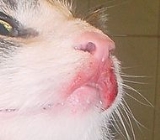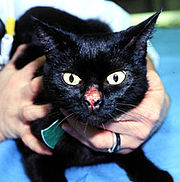
Feline eosinophilic granuloma
Encyclopedia
Eosinophilic granuloma is a form of Langerhans cell histiocytosis
.
It is a condition of both human and veterinary pathology.
Feline eosinophilic granuloma complex is synonymous with feline eosinophilic skin diseases. This is considered to be a cutaneous reaction pattern that can be the manifestation of a number of underlying infections, allergies or ectoparasite infestations. It can also be idiopathic
, that is have no discoverable underlying trigger. The eosinophilic reaction is common in feline inflammatory disease and the eosinophilic granuloma can be a hereditary reaction pattern in some lines of domestic cat
s.
The most frequent form is eosinophilic plaque. This is a rash comprising raised red to salmon-colored and flat-topped, moist bumps scattered on the skin surface. The most common location is on the ventral abdomen and inner thigh.
Another form of EGC is the lip ulcer. This is a painless, shallow ulcer with raised and thickened edges that forms on the upper lip adjacent to the upper canine tooth. It is often found on both sides of the upper lips.
The third form of the EGC is the collagenolytic granuloma. This is a firm swelling that may be ulcerated. The lesions may form on the skin, especially of the face, in the mouth, or on the feet, or may form linear flat-topped raised hairless lesions on the back of the hind legs, also called linear granuloma.
 The least common form of EGC is atypical eosinophilic dermatitis. It is unique in that it is caused by mosquito bite allergy and the lesions form on the parts of the body with the least hair affording easy access to feeding mosquitoes. This includes the bridge of the nose, the outer tips of the ears and the skin around the pads of the feet. The lesions are red bumps, shallow ulcers and crusts.
The least common form of EGC is atypical eosinophilic dermatitis. It is unique in that it is caused by mosquito bite allergy and the lesions form on the parts of the body with the least hair affording easy access to feeding mosquitoes. This includes the bridge of the nose, the outer tips of the ears and the skin around the pads of the feet. The lesions are red bumps, shallow ulcers and crusts.
, ectoparasite infestation or possibly ringworm or other skin infection. Other implicated causes include traumatic damage, autoimmune disease or FeLV infection.
Langerhans cell histiocytosis
Langerhans cell Histiocytosis is a rare disease involving clonal proliferation of Langerhans cells, abnormal cells deriving from bone marrow and capable of migrating from skin to lymph nodes...
.
It is a condition of both human and veterinary pathology.
Feline eosinophilic granuloma complex is synonymous with feline eosinophilic skin diseases. This is considered to be a cutaneous reaction pattern that can be the manifestation of a number of underlying infections, allergies or ectoparasite infestations. It can also be idiopathic
Idiopathic
Idiopathic is an adjective used primarily in medicine meaning arising spontaneously or from an obscure or unknown cause. From Greek ἴδιος, idios + πάθος, pathos , it means approximately "a disease of its own kind". It is technically a term from nosology, the classification of disease...
, that is have no discoverable underlying trigger. The eosinophilic reaction is common in feline inflammatory disease and the eosinophilic granuloma can be a hereditary reaction pattern in some lines of domestic cat
Cat
The cat , also known as the domestic cat or housecat to distinguish it from other felids and felines, is a small, usually furry, domesticated, carnivorous mammal that is valued by humans for its companionship and for its ability to hunt vermin and household pests...
s.
Symptoms
Cats with eosinophilic granuloma complex (EGC) may have one or more of four patterns of skin disease.The most frequent form is eosinophilic plaque. This is a rash comprising raised red to salmon-colored and flat-topped, moist bumps scattered on the skin surface. The most common location is on the ventral abdomen and inner thigh.
Another form of EGC is the lip ulcer. This is a painless, shallow ulcer with raised and thickened edges that forms on the upper lip adjacent to the upper canine tooth. It is often found on both sides of the upper lips.
The third form of the EGC is the collagenolytic granuloma. This is a firm swelling that may be ulcerated. The lesions may form on the skin, especially of the face, in the mouth, or on the feet, or may form linear flat-topped raised hairless lesions on the back of the hind legs, also called linear granuloma.

Causes
Aside from the mosquito allergy cat, cats with ECG usually have allergyAllergy
An Allergy is a hypersensitivity disorder of the immune system. Allergic reactions occur when a person's immune system reacts to normally harmless substances in the environment. A substance that causes a reaction is called an allergen. These reactions are acquired, predictable, and rapid...
, ectoparasite infestation or possibly ringworm or other skin infection. Other implicated causes include traumatic damage, autoimmune disease or FeLV infection.

